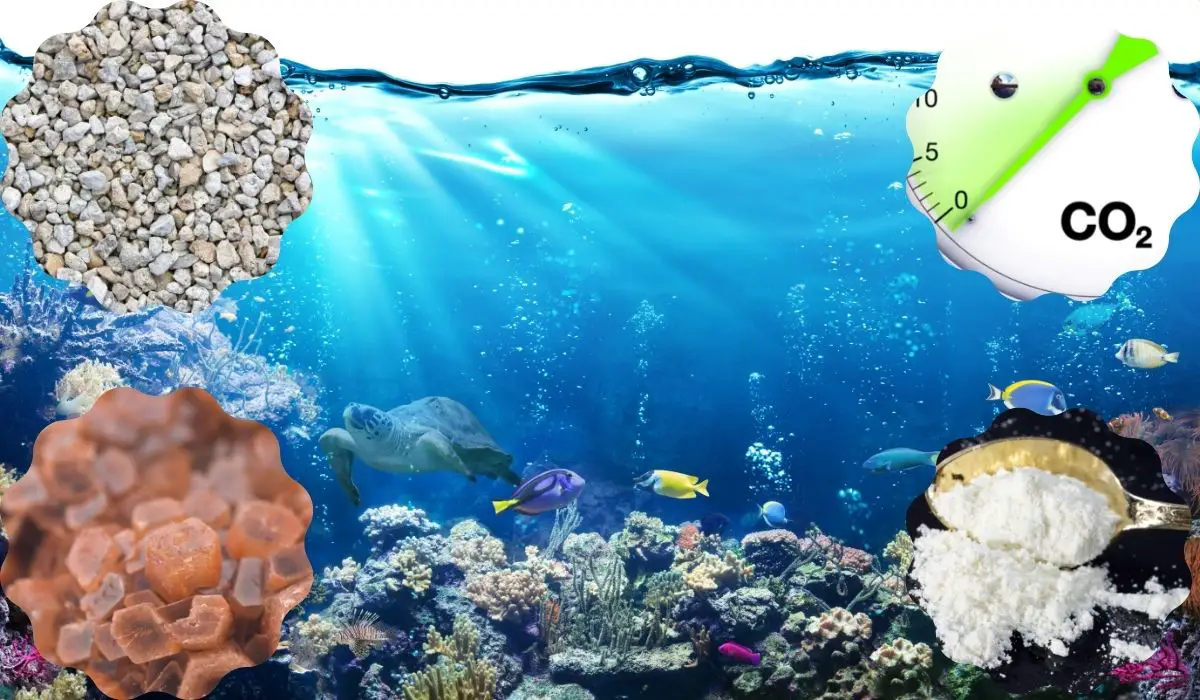Last Updated on January 22, 2022 by admins
How to raise KH in a freshwater aquarium? Click and learn how to save your aquarium from problems that can be caused by low KH.
Distinguishing between GH (general hardness) and KH (carbonate hardness) can be quite difficult and tricky, especially for fishkeeping beginners. However, a bit of insight into water chemistry can help you become a true connoisseur.
Carbonate hardness is one of the factors that can affect the overall health of your underwater ecosystem. Therefore, maintaining balanced water chemistry is one of the best things you can do for your fish tank.
In this article, we will show you how to raise KH in a freshwater aquarium. So, let’s get to the point!
What Is KH In Aquarium?
Before we get to the point, we need to discern what KH actually means. KH stands for carbonate hardness and is expressed in degrees known as dKH. It is a parameter that measures the concentration of dissolved carbonates (CO3) and bicarbonates (HCO3) in aquarium water.
These are common forms of reference to carbonate hardness:
- Alkalinity,
- Temporary Hardness,
- Buffer Capacity,
- Acid-Neutralizing Capacity (ANC).
Does it matter at all? Yes, it does, because KH levels affect water resistance to pH fluctuations. KH acts as a blocker between natural acids and the pH level in your aquarium.
Ideal Kh Level For Freshwater Aquarium
As already mentioned, KH is measured in dKH (degrees KH) or ppm (parts per million), where 1 dKH equals 17.9 ppm. Furthermore, as for the ideal level, freshwater aquariums should be somewhere between 4-8 dKH or 70-140 ppm.
Also, it is important to note that the ideal KH level will depend on the type of fish kept inside as well as whether the aquarium is heavily planted or not.
How To Test And Measure KH Levels In An Aquarium
The best way to check Carbonate Hardness in a freshwater aquarium is to use KH test kits. Testing is simple and will help you determine if you need to increase the alkalinity of your aquarium water.
Here are some recommendations for testing frequency:
- Test once a month if the KH of the water is 4.5 dKH or more;
- Test once a week if the KH of the water is below 4.5 dKH (repeat until you increase the value above 5dKH).
How To Increase Kh In Aquarium?
It is extremely important to remember that an alkalinity level that is close to zero is dangerous. Unfortunately, it can be fatal for your aquatic pets. Here are some instances of how to raise KH in a freshwater aquarium.
Baking Soda
This is one of those ingredients that can be found in almost every household. As for the quantity, it depends on how big the aquarium is. So, for example, one teaspoon of baking soda will be more than enough for a 50-liter tank. This amount will raise the dKH by 4 dKH.
There are some other things you need to pay attention to as well. It is recommended not to put too much baking soda at once as this sudden and drastic change can be fatal for your fish. Also, pay attention when buying; be sure to buy baking soda, not baking powder – as it is not the same thing.
Find more information Adding Baking Soda To An Aquarium
Professional Buffers
Commercial alkalinity buffers are a great way to increase KH levels in your aquarium. Their advantage is that they raise the pH level along with alkalinity (KH). In addition, professional buffers maintain KH levels in an acceptable range between 7.2 and 8.5.
They are designed to make the process as easy and safe as possible. However, like adding any other chemical to the tank, adding too much can be harmful, so follow the instructions carefully!
CO2 Systems
If you notice that the problem of low KH is becoming more common, it might be wise to consider investing in a CO2 aquarium system. Also, one should be careful here as higher CO2 levels can cause a drop in KH levels and pH as well as deprive your fish of oxygen.
However, with this in mind, manufacturers have created automatic systems that can detect when the pH level has dropped and can control CO2 flow accordingly.
Potassium Bicarbonate
Adding potassium bicarbonate to your aquarium is a great live plant fertilizing method, but also a way to raise KH levels. It is recommended to use it in small doses, with regular tests of its effectiveness in raising alkalinity.
Limestone, Dolomite, And Aragonite
Adding limestone, dolomite, or aragonite substrate to your fish tank can help increase KH levels. It is important to emphasize that no matter how good the method is, it is also one of the slowest because the process can last between 2 to 10 weeks.
Thus, e.g., this method will be more suitable for freshwater tanks in which hard water-loving fish such as African cichlids are kept.
Crushed Coral
Adding crushed coral is the healthiest way to change the water parameter in an aquarium! The best thing is that it has the ability to slowly and steadily increase the carbonate hardness of the water.
Crushed corals slowly dissolve in water and during this process release calcium and carbonate ions into the water, which ultimately raises KH as well as GH levels. It is recommended to tie crushed corals in a filter media bag and add it to the tank’s filtering system.
Final Thoughts
Carbonate hardness acts as a protective buffer that raises water resistance to drastic changes in pH. Therefore, maintaining as stable a pH level as possible is vital for fish and plant health.
Finally remember, whichever method you choose, try to keep the KH level in the freshwater aquarium in the range between 4-8 dKH to keep the pH level in the tank constant.
Write us some of your methods on how to grow KH in a freshwater aquarium in the section below. We look forward to hearing your ideas!
Read more about How To Reduce Water Hardness In An Aquarium


